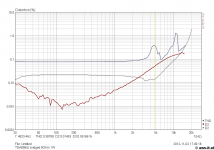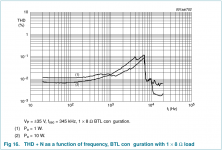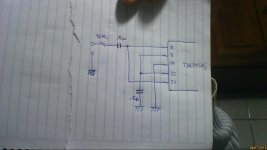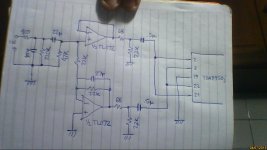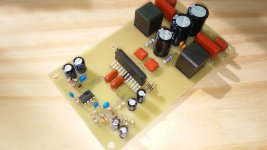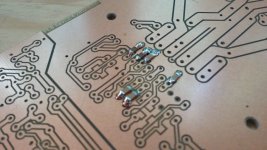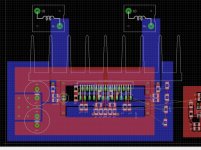I have also tried to reduce rail voltage, but with no improvement. The improvement i have is only with gnd directly between PSU main caps. right and left input gnd is connected and only one wire from one input to main caps gnd. I took this method directly from LC audio cook book
Compare the very optimistic datasheet values with a real life measured and build your own opinion if it is worth to continue using this chip.
- Datasheet amplifier is running (probably with stabilized) power supply at +/- 35V and 345 kHz
- tested TDA8950j Amplifier was running with synchronized 375kHz and +/- 31V.
Attachments
It's probably not worth it. The chip does sound really good for subwoofer use, so it's a pity it have this fault. One user have reported a cheap chinese module without the fuzz, so it should be possible.
I'm curious what your fix was, as you never did post the correction schematic. 🙂 I have the same issue with high distortion at very low levels, almost a fuzz that is overlaying the signal. It is very prominent with solo piano. Please share your fix...if you don't mind!
fishintowater reported that he was able to correct some portion of this low level distortion, and that is the information I am looking for. I understand that there will always be a high-ish (0.5%) level of distortion between 5-7kHz, but what I am talking about is much worse than that. I wonder if I don't have the same error on my boards as fishintowater found on his. Maybe I will send a PM.
Hi ungie, I answered your PM yesterday but I guess I need to coment here for everyone. I have my amp suspended by the moment due to a priority work I have to do now, but I intend to get back on it asap!
The FIX I've found really was around the buzz at very low power but for my application the amp is well justified (at least for me) because I am using it as a bass amp, so the high frequency for me is meaningful only up to 5 or 6 khz, so the peak distortion at 10khz that Toni mention is not an issue for me.
So my opinion is, for subwoofers or bass amps like mine is quite acceptable (depending on listener sensitivity 🙂), but for hi-fi definetely go with another option!!!
Regards
Rei.
#59 is a hint to ground induced distortion. This can happen easyly in case the the ac-current through the blocking caps adds to the signal in some way.
And I do not assume nxp give obviously fake data - more likely there is something wrong with the layout.
And I do not assume nxp give obviously fake data - more likely there is something wrong with the layout.
That is the balancing circuit from ESP. It us a simple circuit but credit should go to Rod Elliott at http://www.sound.westhost.com/project14.htm
Last edited:
That is the balancing circuit from ESP. It us a simple circuit but credit should go to Rod Elliott at Bridging Adapter For Power Amps
Sorry, but this is well known simple opamp circuit and can be found in many books and datasheets. The Opamp balanced circuit from post #1 was designed by me directly from memory thinking about opamp circuits which I have worked with in 1982 or so. Long before the internet for public started ...
This circuit was NOT taken from (of course really good and informative!) Rod's homepage.
Thank you everyone for your suggestions and pointers. My application is a little different than most here as I am using the amplifier in stereo instead of BTL and I have no input buffer. Initially I tried the suggestion to tie the input ground to the main star ground with a thick wire, with no improvement. By chasing my tail trying a number of different things, I noticed that the distortion at very low levels (well below 1W into 6ohms) was different between the two channels. This lead me to think about having one input inverted to reduce bus pumping as suggested by NXP (not just them, of course). Lo and behold, when I ignored the datasheet (creating possible issues due to bus pumping) and connected both inputs with the same polarity, the low level distortion disappeared and both channels now exhibit the same level of distortion. For low level, near-field listening this change has completely removed any of the issues I have been hearing. Strange!
Hello everyone!.. I was absent a long time but finally I found the space to come back to this project using the boards of astx as the power stage of a bass amplifier. Some pics below.
I believe it could be quite suitable for a bass amp, the distortion figures should not represent a big deal... anyway, I intend to make a preamp for this using FETs emulating tubes. I spent a some time studying the case of the inherent distrortion of the tubes in guitar amps so the distortion of the TDA8950 would be negligible for this application 😀
For the experiment I cloned the board of astx using the gerber files but for my final project I am designing a dual layer board myself. The third pic is a screen capture of my (incomplete yet) design.
I hope to finish is as quick as possible and not spend another year to complete it... 😀😀😀
That's all by now!
Regards!
Rei.
I believe it could be quite suitable for a bass amp, the distortion figures should not represent a big deal... anyway, I intend to make a preamp for this using FETs emulating tubes. I spent a some time studying the case of the inherent distrortion of the tubes in guitar amps so the distortion of the TDA8950 would be negligible for this application 😀
For the experiment I cloned the board of astx using the gerber files but for my final project I am designing a dual layer board myself. The third pic is a screen capture of my (incomplete yet) design.
I hope to finish is as quick as possible and not spend another year to complete it... 😀😀😀
That's all by now!
Regards!
Rei.
Attachments
Dear Rei,
any progress? Looks good so far - your home brew pcb. It's funny to see this old project still alive...
IMHO you can use the TDA8950 very good as subwoofer amp. The distortion increases above 6 kHz so no problem here.
BR, Toni
any progress? Looks good so far - your home brew pcb. It's funny to see this old project still alive...
IMHO you can use the TDA8950 very good as subwoofer amp. The distortion increases above 6 kHz so no problem here.
BR, Toni
Dear Rei,
any progress? Looks good so far - your home brew pcb. It's funny to see this old project still alive...
IMHO you can use the TDA8950 very good as subwoofer amp. The distortion increases above 6 kHz so no problem here.
BR, Toni
Hi Toni, thank you 🙂
I think it has potential for a bass amp application... even with trebles slapping the bass guitar... from the rock music point of view a bit of distortion won't hurt too much! 😀
This week I should have it working and running tests... and of course playing my bass to hear how it feels with this amp compared to my bass amp head with class AB power stage!
I'll keep you posted!
Regards!
Rei.
Dear Stewin,
the project is finished a long time ago. I have replaced the TDA8950 modules by a diyaudio users very nice Class D amps - see this thread post 54 and post 55.
BR, Toni
the project is finished a long time ago. I have replaced the TDA8950 modules by a diyaudio users very nice Class D amps - see this thread post 54 and post 55.
BR, Toni
... does it fit? ...
they look very nice. was there any hf noise and have you ever tried to remove one speaker from the amp when the amp is working?
Thx! Yes Chocoholic has done a perfect job designing his Class D lite amp series (based on IRS2092: SystemD LiteAmp)
I like them very much! The 4 channel Amp is driving my 4 Subwoofers every day. No noise and no hiss!
During testing I have removed/added many times the connections.
What should be expected in your opinion if I remove speakers when running? (Except silence of course!)
BR, Toni
I like them very much! The 4 channel Amp is driving my 4 Subwoofers every day. No noise and no hiss!
During testing I have removed/added many times the connections.
What should be expected in your opinion if I remove speakers when running? (Except silence of course!)
BR, Toni
Thx! Yes Chocoholic has done a perfect job designing his Class D lite amp series (based on IRS2092: SystemD LiteAmp)
I like them very much! The 4 channel Amp is driving my 4 Subwoofers every day. No noise and no hiss!
During testing I have removed/added many times the connections.
What should be expected in your opinion if I remove speakers when running? (Except silence of course!)
BR, Toni
thanks toni for the reply, in my experience with class d sigma delta (irs900 , 1k5 etc) i had a bad experience , when i remove the speaker or load when the amp is on , it becomes unstable , burns the fuse and most of the times output fets. but with load connected it worked well no issues. aud600 by manoj worked well but when oc protection board is removed it fails the same way. 😕😕 ucd was better but issue was taming the hiss noise
Last edited:
Thats not good! If the amp becomes unstable without load there would be a major design error. Bad PCB layout, compensation wrong, defective or wrong dimensioned snubbers.
Bus bumping could also be a problem. A bridged design has no such problems and both of my variants are bridged.
My TDA8950 Layout has worked without any problems (except the bad THD performance by chip design).
My bridged class D lite amp (by Chocoholic) is also ultrastable with or without load.
BR, Toni
Bus bumping could also be a problem. A bridged design has no such problems and both of my variants are bridged.
My TDA8950 Layout has worked without any problems (except the bad THD performance by chip design).
My bridged class D lite amp (by Chocoholic) is also ultrastable with or without load.
BR, Toni
- Home
- Amplifiers
- Class D
- 4 x BTL 300W/8R - a TDA8950j based 4 channel power amplifier
